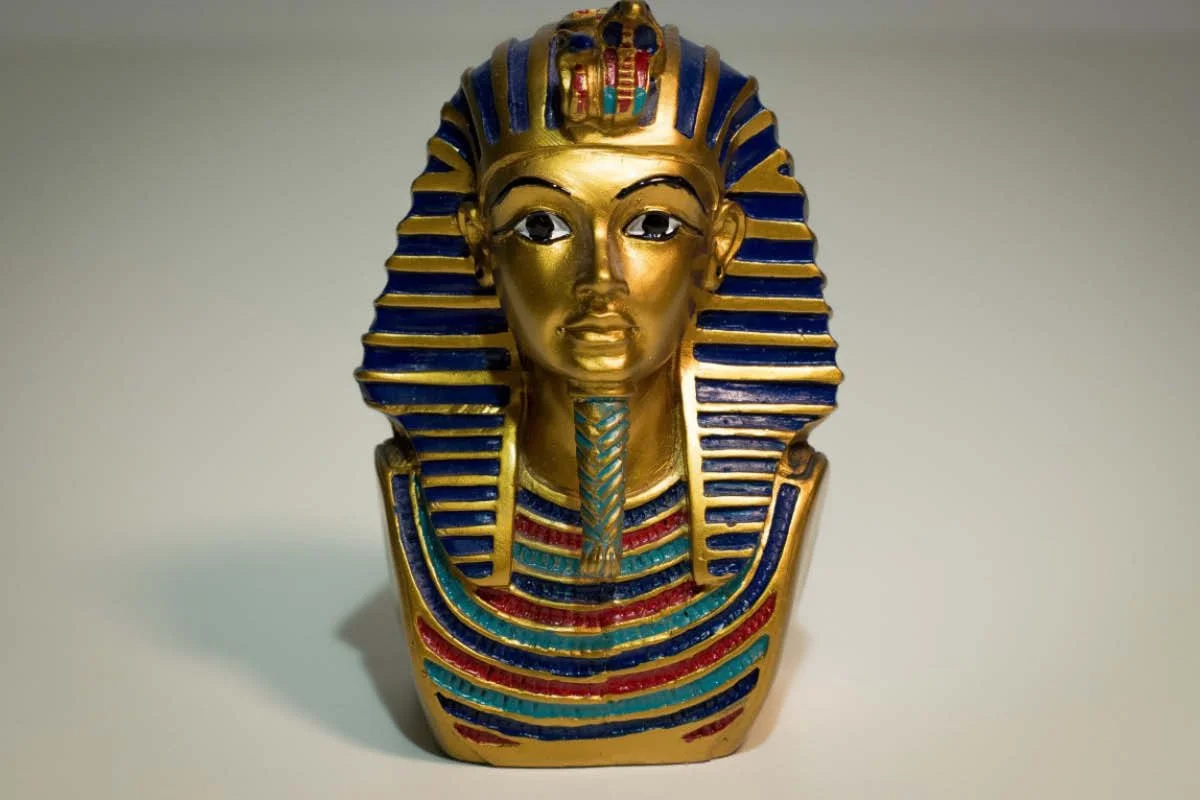A Visual Framework for Studying Egyptian Sculptures
Fragmentary bust of Amenemhat III, 12th Dynasty (c. 1850–1800 BCE).
Stand in front of a pharaoh and you can “read” a lot fast. Pose, hands, and gaze are a code for power and presence, while stone choice and scale tell you where the image belonged. Egyptian statues aren’t frozen; they’re active images built to work in temples and courts. Below is a simple framework to make sense of stance, materials, and settings—with examples you can test on your next museum visit. For bigger context on sacred buildings that housed these images, keep our guide to ancient Egyptian architecture close by.
Definition
Frontality: a face-forward, symmetrical stance meant to address gods and people directly.
Pose is a code: stance, fists, and gaze
Egyptian sculptors repeat a small set of poses because each one does a job. The standing striding figure (often left foot forward) signals permanent movement, a king eternally advancing in ritual space. The seated enthroned figure projects stable rule; thighs and knees form strong planes that read from far away in courtyards. The kneeling offering pose—king on both knees presenting round jars—shows active service to the gods. There are also Osiride figures, arms crossed and body wrapped, used on pillars and façades to bind the king to the eternal form of Osiris.
Hands matter. A closed fist on the thigh can grip a rolled cloth or sekhem (power) scepter; the open hand lays flat to steady the body’s plane. Add regalia and the message sharpens: nemes headcloth frames the face; uraeus cobra marks divine protection; the false beard switches the portrait into ritual mode. Faces lean to ideal rather than personal likeness, with almond eyes and calm mouths that hold the image between human and divine. The forward gaze is not casual looking—it is presence aimed at a god’s shrine or a public axis. Read pose, then hands, then headgear; together they tell you what the statue is doing in its place.
Tutankhamun souvenir [Modern replica].
Material choice tells rank and reach
Egyptian artists matched material to message. Limestone and wood shape private and mid-scale statues well; they carve easily and hold paint. Hard stones—granodiorite, diorite, basalt, greywacke—carry royal images that must last and read strongly under sun. Hard stones take a tight polish that catches light like water; a dark, glossy surface makes the body look compact and powerful. When ritual demanded radiance, craftsmen added gilding or inlaid eyes. Small bronzes appear late, but stone stays the backbone because it wears time well and anchors statues to place.
Material also maps logistics. Hard stones traveled far, from quarries like Aswan or the Eastern Desert, then up the Nile to temple workshops. That journey is part of the image’s prestige: a statue made of stubborn stone tells you the state can command distance and skill. Notice where stone shifts inside one figure—granite for a head or core, limestone for repaired limbs—and you can see workshops solving problems while keeping the message intact. In short: soft stones for speed and paint, hard stones for authority and durability.
Horus as a falcon with the Double Crown, Late Period; State Museum of Egyptian Art, Munich.
Scale and setting change meaning
A statue’s job depends on where it stands. At gateways and courts, colossi—towering seated or striding figures—work like architectural piers. They frame movement and declare power at a distance. Ramesses II at Abu Simbel and Amenhotep III’s memorial colossi are classic cases; browse our field guide to the largest Egyptian statues to see where scale peaks and why.
Move inward and scale drops. In hypostyle halls and sanctuaries, you meet mid-size royal statues that receive offerings or accompany the god’s bark during festivals. Here the polish, inscriptions, and exact pose matter more than height because viewers stand close. In tombs and chapels, ka statues—a stand-in body for the life-force—sit behind screens or in niches to “receive” food and voice offerings. The same king can exist in all these sizes at once. What changes is the setting and the task: announce at the gate, participate in ritual inside, secure memory in the chapel. Architecture and sculpture are one system, which is why understanding temples is a shortcut to understanding statues; keep ancient Egyptian architecture in your back pocket when you look.
A quick, reusable framework
When you meet an Egyptian statue, three questions organize everything fast:
What is the pose doing? Striding, seated, kneeling, Osiride—each signals a role.
What is it made of? Soft stone or wood suggests paint and proximity; hard, polished stone signals endurance and rank.
Where would it live? Gate, court, sanctuary, or tomb niche ties the message to a place and audience.
That’s your pocket framework: pose + material + setting. Use it once and you’ll never look at Egypt’s statues the same way.
Funerary model of a kneeling worker preparing food, Middle Kingdom (c. 2000–1700 BCE).
Conclusion: statues as clear, durable messages
Egyptian statues are texts in stone. A stance says “advance” or “serve.” Hands and regalia lock in office and power. Material and polish deliver rank and longevity, and setting lines up the audience—crowd, god, or family. Once you tune into that system, every figure becomes readable without guesswork. To see how scale pushes these messages to the limit, jump to largest Egyptian statues—then swing back through our ancient Egyptian architecture primer to place images in their rooms and routes.
Sources and Further Reading
UCLA Encyclopedia of Egyptology — “Wooden Statuary” (2009) (PDF)
Oxford Research Encyclopedia of Religion — “Ancient Egyptian Religion” (2018)
Heilbrunn Timeline of Art History, The Met — “Materials and Techniques of Egyptian Sculpture” (n.d.)
Heilbrunn Timeline of Art History, The Met — “Egyptian Faience: Technology and Production” (2017)













